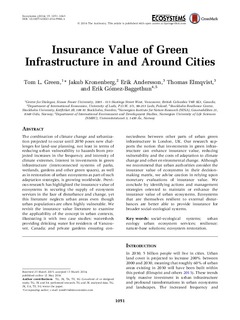| dc.contributor.author | Green, Tom L. | |
| dc.contributor.author | Kronenberg, Jakub | |
| dc.contributor.author | Andersson, Erik | |
| dc.contributor.author | Elmqvist, Thomas | |
| dc.contributor.author | Gomez-Baggethun, Erik | |
| dc.date.accessioned | 2016-11-11T13:15:17Z | |
| dc.date.accessioned | 2018-01-02T12:11:45Z | |
| dc.date.available | 2016-11-11T13:15:17Z | |
| dc.date.available | 2018-01-02T12:11:45Z | |
| dc.date.issued | 2016 | |
| dc.identifier.citation | Ecosystems (New York. Print) 2016, 19:1051-1063 | nb_NO |
| dc.identifier.issn | 1435-0629 | |
| dc.identifier.uri | http://hdl.handle.net/11250/2474025 | |
| dc.description | - | nb_NO |
| dc.description.abstract | The combination of climate change and urbanization projected to occur until 2050 poses new challenges for land-use planning, not least in terms of reducing urban vulnerability to hazards from projected increases in the frequency and intensity of climate extremes. Interest in investments in green infrastructure (interconnected systems of parks, wetlands, gardens and other green spaces), as well as in restoration of urban ecosystems as part of such adaptation strategies, is growing worldwide. Previous research has highlighted the insurance value of ecosystems in securing the supply of ecosystem services in the face of disturbance and change, yet this literature neglects urban areas even though urban populations are often highly vulnerable. We revisit the insurance value literature to examine the applicability of the concept in urban contexts, illustrating it with two case studies: watersheds providing drinking water for residents of Vancouver, Canada; and private gardens ensuring connectedness between other parts of urban green infrastructure in London, UK. Our research supports the notion that investments in green infrastructure can enhance insurance value, reducing vulnerability and the costs of adaptation to climate change and other environmental change. Although we recommend that urban authorities consider the insurance value of ecosystems in their decisionmaking matrix, we advise caution in relying upon monetary evaluations of insurance value. We conclude by identifying actions and management strategies oriented to maintain or enhance the insurance value of urban ecosystems. Ecosystems that are themselves resilient to external disturbances are better able to provide insurance for broader social–ecological systems. social–ecological systems; urban ecology urban ecosystem services; resilience; nature-base solutions; ecosystem restoration. | nb_NO |
| dc.language.iso | eng | nb_NO |
| dc.rights | Navngivelse 4.0 Internasjonal | * |
| dc.rights.uri | http://creativecommons.org/licenses/by-nc-nd/4.0/deed.no | * |
| dc.title | Insurance value of green infrastructure in and around cities | nb_NO |
| dc.type | Journal article | nb_NO |
| dc.type | Peer reviewed | nb_NO |
| dc.date.updated | 2016-11-11T13:15:17Z | |
| dc.subject.nsi | VDP::Samfunnsvitenskap: 200::Urbanisme og fysisk planlegging: 230 | nb_NO |
| dc.subject.nsi | VDP::Social sciences: 200::Urbanism and physical planning: 230 | nb_NO |
| dc.identifier.doi | 10.1007/s10021-016-9986-x | |
| dc.identifier.cristin | 1366506 | |
| dc.subject.keyword | Byøkologi / Urban Ecology | |
| dc.subject.keyword | Resiliens / Resilience | |

